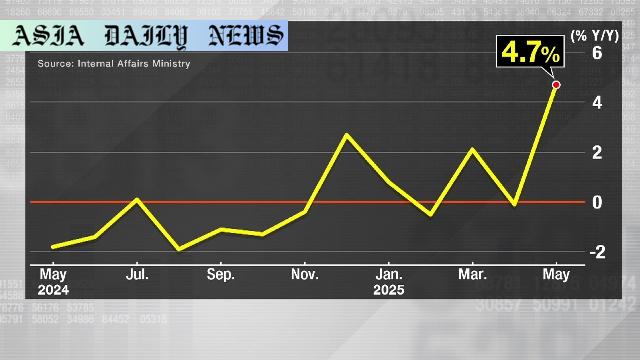Household Spending: Japan records a significant 4.7% rise in household expenditure driven by increased spending on cars and travel.
Spending by Japan’s households increased 4.7% in May, first significant rise in two months.
Higher spending on cars and travel boosted the increase in household expenditures.
Rice and meat purchases declined due to high prices, while noodles and fresh vegetables saw increased spending.

Japan’s Household Spending Sees Positive Growth
For the first time in two months, Japan has achieved a notable rise in household spending, with expenditures increasing by 4.7% year-on-year in May. This growth marks the largest increase since August 2022, driven by consumer spending on cars and travel. According to the internal affairs ministry, the average spending by households of two or more people reached just over 316,085 yen (approximately $2,200). This surge highlights a shift in consumer behavior amid an evolving economic landscape, reflecting greater confidence and demand in key areas of the market.
Spending Trends in Key Categories
While the overall household expenditure rose, spending patterns revealed interesting trends within specific categories. Expenditures on food saw a modest 1% increase, although certain staple items exhibited contrasting results. For example, spending on rice fell sharply by 8.2%, marking the steepest decline since November 2022. Conversely, noodles experienced a sharp rise of 7.6%, likely due to their affordability and versatility. Meanwhile, spending on fresh vegetables grew by 3.7%, which could signify a shift toward healthier consumer choices. On the other hand, meat spending slipped by 2%, potentially due to high inflation discouraging purchases of these traditionally expensive items.
Understanding the Impact of Inflation on Consumer Choices
The nuances in Japan’s household spending underline the significant influence of inflation on consumer behavior. Ministry officials noted that high prices for rice and meat likely deterred purchases, prompting consumers to seek alternatives such as noodles and fresh produce. This shift could reflect both economic pressures and a growing awareness of cost-cutting measures among consumers. However, the increased spending on cars and travel suggests a different dimension – one indicating a rebound in discretionary expenditures as households gradually regain confidence in their financial stability.
Economic Implications and Outlook for Japan
The rise in household spending serves as a positive indicator for Japan’s economic recovery, providing a much-needed boost to the domestic market. Increased expenditures in categories like cars and travel may signal post-pandemic recovery trends, with pent-up demand being released as travel restrictions ease and consumer mobility improves. Additionally, this spending upswing could encourage businesses to reinvest in growth areas, further revitalizing the economy. However, continued vigilance regarding inflationary pressures remains crucial to sustain this momentum, ensuring that consumers’ purchasing power and confidence are not undermined by rising costs.
Conclusion
Japan’s recent rise in household spending paints an optimistic picture for the country’s economic trajectory. Bolstered by strategic spending in areas like travel, cars, and fresh produce, households appear to be navigating inflation challenges while fueling economic recovery. While certain segments, such as rice and meat, reflect the lingering impact of high prices, the overall trend suggests resilience and adaptability among Japanese consumers. Moving forward, policymakers and businesses must work collaboratively to address inflation concerns and nurture this positive trajectory for the benefit of the broader economy.



Commentary
Japan’s Spending Growth as a Positive Economic Signal
The recent growth in Japan’s household spending carries significant implications for both the economy and consumer confidence. After two months of decline, the 4.7% year-on-year rise reflects a pivotal turning point, driven by increased expenditures on cars and travel. Such sectors are often indicative of positive consumer sentiment, as they require higher discretionary budgets. This demonstrates that not only are Japanese households adjusting their finances to inflation, but many are also reclaiming opportunities to invest in leisure and transportation, marking a shift toward normalcy.
Inflation’s Role in Shaping Consumer Behavior
One of the most striking aspects of the report is how inflation has influenced spending choices. Although food prices increased modestly, the steep declines in rice and meat expenditures have shown how persistent inflationary pressures discourage consumers from purchasing pricier staples. On a brighter note, increased spending on noodles and fresh vegetables indicates how consumers are selectively adapting their consumption habits. By seeking out more affordable or sustainable alternatives, households are demonstrating both resilience and flexibility in the face of economic pressures.
The Broader Implications for Japan’s Economy
From a macroeconomic perspective, the spending increase offers hope for sustained growth, particularly in recovering sectors like travel. It also suggests that government measures to manage inflation could influence long-term consumer confidence positively, provided they remain effective. However, the data also shows that inflation continues to cast a shadow over certain essential categories, underscoring the need for targeted interventions to curb price volatility. Moving forward, ensuring balanced spending across essential and discretionary sectors will be critical for maintaining the upward trajectory of the economy.
Final Thoughts
Japan’s household spending for May has delivered a promising glimpse into its post-pandemic recovery journey. The challenges posed by inflation are evident, yet the resilience of consumers shines through as they prioritize both necessities and discretionary pleasures. Through a careful balance of economic policies and support for vulnerable sectors, Japan can continue to foster growth in a way that benefits businesses and consumers alike. As we monitor future spending trends, it will be fascinating to see whether this rise is the beginning of a sustained recovery or merely a temporary surge.